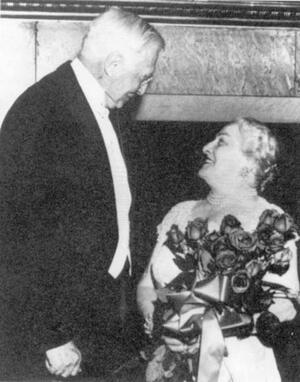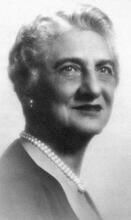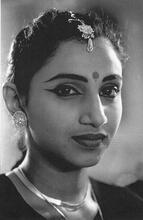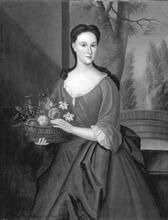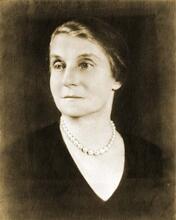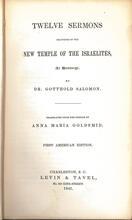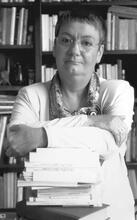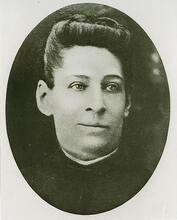Sadie Cecilia Annenberg
Sadie Cecelia Friedman Annenberg gave generously to Jewish causes both in the United States and Israel. In 1899, she married Moe Louis Annenberg, who pawned her jewelry to start a news distribution agency and a mail order business, making the couple millionaires. She used their wealth to support causes she cared about, including the Sadie Cecelia Annenberg Music School of the Williamsburg Settlement House and Richard Nixon’s campaigns. Annenberg quietly weathered her husband’s indictment for tax fraud and subsequent death, while continuing philanthropic work such as gifts to Israel. Her family honored her with a one million dollar grant to the Albert Einstein College of Medicine at Yeshiva University, and her children pledged eight million dollars to the Mount Sinai School of Medicine.
“If you love something, you will find a way to care for it, whether it is a person or an institution.” This was the personal credo of Sadie Cecilia Annenberg, loving wife, dedicated mother, and philanthropic contributor to educational, political, and Jewish causes.
Early life, marriage, and millions
Born in New York City on June 3, 1879, Sadie Cecilia (Friedman) Annenberg was the daughter of a retail shoe salesman who later moved his family to Chicago. The small, round, fiery-haired Sadie married a “lean, hungry wolf,” Moses (Moe) Louis Annenberg, on August 20, 1899. While her husband pursued opportunities in the newspaper industry, Annenberg bore nine children: Diana (who died at age five), Esther, Pearl, Janet, Enid, Walter, Leah, Evelyn, and Harriet.
In 1907, the Annenbergs moved to Milwaukee, where Moe established his own news distribution agency by pawning some of his young wife’s jewelry for $700 and borrowing another $1,500. Sadie is credited with inspiring a mail-order business that made the Annenbergs millionaires by their thirties. Moe recalled, “I asked my wife what among household articles of a durable nature she found herself buying oftenest. She answered quickly—teaspoons. I decided to try this. . . . My wife was right. Every woman in creation seemed to want these spoons. . . . Little Woman [Moe’s nickname for Sadie] . . . made us a fortune.”
By all accounts, the Annenbergs’ marriage was happy. The couple differed only when it came to religion. “Little Woman” was observant; she faithfully attended synagogue and kept a Term used for ritually untainted food according to the laws of Kashrut (Jewish dietary laws).kosher (kasher) home. Her husband, however, rejected his ties to Judaism.
In 1917, when Moe took a job with William Randolph Hearst, the family relocated to New York. By 1920, the Annenbergs were dividing their time between a Manhattan apartment and a Long Island estate. Though fashion-conscious and well-dressed, Annenberg was “a simple woman . . . at home in the kitchen.” In 1926, Moe left Hearst to build his own publishing empire, which included the Philadelphia Inquirer.
Moe’s downfall and Sadie’s turn to philanthropy
In 1939, Moe and his only son, Walter, were indicted by the federal government for tax evasion. To avoid public humiliation, Annenberg and her daughters waited in a nearby hotel as the verdict was handed down. Moe was found guilty of one charge of tax evasion. He also agreed to pay the United States Treasury $9.5 million. Her husband’s incarceration caused Annenberg great pain, but she weathered the dishonor in silence. Moe Annenberg was released in June 1942; one month later, he died.
Before his death, Sadie Annenberg had become involved in philanthropic activities. Her support of the same causes as financier Bernard Baruch won his friendship. In the arts, she was the benefactor of the Sadie Cecilia Annenberg Music School of the Williamsburg (Brooklyn) Settlement House. She received the school’s gold medal of appreciation in 1956.
Sadie Annenberg’s public legacy
In the political realm, Annenberg was a major contributor to Senator Richard M. Nixon’s campaigns. When he became vice president, Nixon hosted a dinner in his home in her honor.
Annenberg made several gifts to the State of Israel, including the establishment of the Sadie C. Annenberg Soil and Irrigation Institute at Gilat. In 1960, she donated $250,000 to the United Jewish Appeal to develop arable land in the Negev. In 1962, her family honored her by giving a $1 million grant to the Albert Einstein College of Medicine at Yeshiva University in New York City. In June 1965, each of her eight children pledged $1 million toward the construction of the Mount Sinai School of Medicine.
On July 6, 1965, Annenberg died in her home in New York. Her influence lives on in the philanthropic activities of Walter Annenberg, who continues to champion the kind of causes that excited his mother’s generosity.
AJYB (1967): 531, s.v. “Necrology”.
Annenberg, Moses L. Obituary. NYTimes, July 21, 1942, 19:1.
Cooney, John E. The Annenbergs (1982).
DAB 3: 19.
EJ; Fonzi, Gaeton. Annenberg: A Biography of Power (1970).
Fischel, Jack, and Sanford Pinsker, eds. Jewish American History and Culture: An Encyclopedia (1992).
Obituary. NYTimes, July 7, 1965, 37:4.

